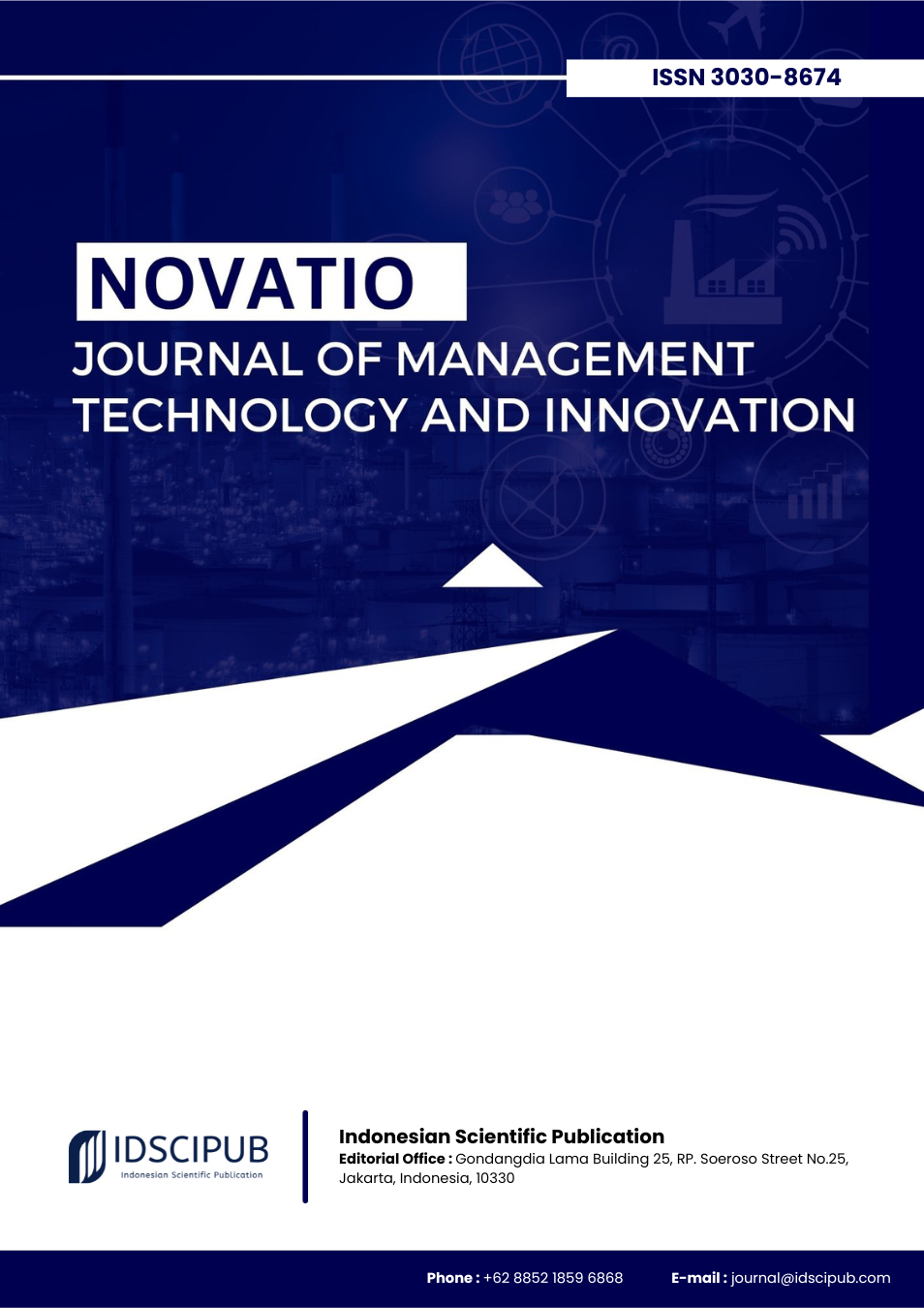Cybersecurity and Innovation Risk Management: Organizational Responses in the Digital Era
DOI:
https://doi.org/10.61978/novatio.v3i4.1029Keywords:
Cybersecurity Risk Management, Digital Transformation, Artificial Intelligence in Security, Blockchain and Data Protection, Organizational Resilience, Healthcare Cybersecurity, International Policy FrameworksAbstract
The rapid pace of digital transformation has reshaped healthcare, finance, and energy sectors, creating opportunities for innovation while amplifying vulnerabilities to cyber threats. This narrative review synthesizes organizational responses to cybersecurity and innovation risk management across global contexts. Literature was systematically collected from Scopus, Web of Science, PubMed, and Google Scholar using defined keywords and inclusion criteria, with thematic synthesis guided by review standards. Four central themes emerged: (1) the effectiveness of secure access and identity management in protecting sensitive data, (2) the integration of artificial intelligence and blockchain in predictive modeling and threat detection, (3) measurable improvements in resilience through advanced technological adoption, and (4) the influence of systemic and structural factors, including governance frameworks and international collaboration. Evidence highlights disparities between developed and developing regions, where resource and infrastructure limitations hinder adoption. The discussion links findings with resilience theory while noting limitations such as the neglect of SMEs, dominance of Western perspectives, and reliance on secondary data. Policy implications emphasize capacity-building, harmonized frameworks, and innovation-driven cultures. Comprehensive, collaborative, and context-sensitive approaches are essential for advancing cybersecurity resilience in the digital era.
References
Adriko, R., & Nurse, J. (2024). Cybersecurity, cyber insurance and small-to-medium-sized enterprises: a systematic review. Information and Computer Security, 32(5), 691-710. https://doi.org/10.1108/ics-01-2024-0025 DOI: https://doi.org/10.1108/ICS-01-2024-0025
Anwar, S. (2025). Ai-driven risk management in online financial transactions: enhancing cybersecurity in the fintech era. International Journal of Innovative Research and Scientific Studies, 8(4), 328-335. https://doi.org/10.53894/ijirss.v8i4.7784 DOI: https://doi.org/10.53894/ijirss.v8i4.7784
Babu, C., Logapadmini, B., Regash, K., & Biruntha, R. (2025). Cybersecurity and privacy concerns in digital health., 397-414. https://doi.org/10.4018/979-8-3693-8774-0.ch020 DOI: https://doi.org/10.4018/979-8-3693-8774-0.ch020
Dutta, P., Das, S., & Ganguly, D. (2024). Safeguarding business in the age of ai for organizational resilience and risk management., 78-101. https://doi.org/10.4018/979-8-3693-1198-1.ch005 DOI: https://doi.org/10.4018/979-8-3693-1198-1.ch005
Etemadi, N., Gelder, P., & Strozzi, F. (2021). An ism modeling of barriers for blockchain/distributed ledger technology adoption in supply chains towards cybersecurity. Sustainability, 13(9), 4672. https://doi.org/10.3390/su13094672 DOI: https://doi.org/10.3390/su13094672
Gellert, G., Kelly, S., Hsiao, A., Herrick, B., Weis, D., Lutz, J., … & Johnston, D. (2022). Covid-19 surge readiness: use cases demonstrating how hospitals leveraged digital identity access management for infection control and pandemic response. BMJ Health & Care Informatics, 29(1), e100680. https://doi.org/10.1136/bmjhci-2022-100680 DOI: https://doi.org/10.1136/bmjhci-2022-100680
Jaloliddin, R. (2023). Digitalization in global trade: opportunities and challenges for investment. Global Trade and Customs Journal, 18(10), 391-395. https://doi.org/10.54648/gtcj2023043 DOI: https://doi.org/10.54648/GTCJ2023043
Karakaya, T. (2025). Securing digital transformation., 123-144. https://doi.org/10.4018/979-8-3693-6417-8.ch006 DOI: https://doi.org/10.4018/979-8-3693-6417-8.ch006
Kedarya, T., & Elalouf, A. (2023). Risk management strategies for the banking sector to cope with the emerging challenges. Foresight and Sti Governance, 17(3), 68-76. https://doi.org/10.17323/2500-2597.2023.3.68.76 DOI: https://doi.org/10.17323/2500-2597.2023.3.68.76
Keeley, D. (2024). Healthcare providers’ readiness to address medical device cybersecurity within the irish healthcare system. Global Clinical Engineering Journal, 6(2), 30-39. https://doi.org/10.31354/globalce.v6i2.158 DOI: https://doi.org/10.31354/globalce.v6i2.158
López-López, Y., Martínez, N., García, V., & Martínez, F. (2022). Organizational resilience: 30 years of intellectual structure and future perspectives. Iberoamerican Journal of Science Measurement and Communication, 2(2). https://doi.org/10.47909/ijsmc.37 DOI: https://doi.org/10.47909/ijsmc.37
Movahed, A., Abyaneh, A., Khakbazan, M., & Movahed, A. (2025). Smart economy cybersecurity., 49-72. https://doi.org/10.4018/979-8-3693-4369-2.ch004 DOI: https://doi.org/10.4018/979-8-3693-4369-2.ch004
Peralta, F., Gorton, A., Watson, M., Bays, R., Boles, J., Gorton, B., … & Powers, F. (2020). Cybersecurity resiliency of marine renewable energy systems‐part 1: identifying cybersecurity vulnerabilities and determining risk. Marine Technology Society Journal, 54(6), 97-107. https://doi.org/10.4031/mtsj.54.6.9 DOI: https://doi.org/10.4031/MTSJ.54.6.9
Priya, N., Masudin, I., & Zulfikarijah, F. (2025). The impact of cross-border logistics and e-commerce on sustainable supply chain management in the digital age., 309-336. https://doi.org/10.4018/979-8-3373-0528-8.ch014 DOI: https://doi.org/10.4018/979-8-3373-0528-8.ch014
Radvilė, E., & Urbonas, R. (2025). Digital transformation in energy systems: a comprehensive review of ai, iot, blockchain, and decentralised energy models. Energetika, 71(1). https://doi.org/10.6001/energetika.2025.71.1.1 DOI: https://doi.org/10.6001/energetika.2025.71.1.1
Sabkara, M., Aliyari, M., & Lajevardi, M. (2025). Emerging technologies in financial process optimization and risk management., 17-32. https://doi.org/10.4018/979-8-3693-4369-2.ch002 DOI: https://doi.org/10.4018/979-8-3693-4369-2.ch002
Sayari, K., Firdouse, M., & Abri, F. (2025). Artificial intelligence and machine learning adoption in the financial sector: a holistic review. IAES International Journal of Artificial Intelligence (IJ-AI), 14(1), 19. https://doi.org/10.11591/ijai.v14.i1.pp19-31 DOI: https://doi.org/10.11591/ijai.v14.i1.pp19-31
Shobarani, R., Muthuveerappan, C., Priscilla, G., Suganthi, T., Santhi, S., & Surekha, R. (2023). Securing the future., 383-402. https://doi.org/10.4018/978-1-6684-9317-5.ch019 DOI: https://doi.org/10.4018/978-1-6684-9317-5.ch019
Solaimalai, G., Mary, S., Kamma, V., Malini, K., Karthikumar, K., & Sudhakar, M. (2024). Harnessing digitalization and internet of things for sustainable energy., 231-262. https://doi.org/10.4018/979-8-3693-2827-9.ch008 DOI: https://doi.org/10.4018/979-8-3693-2827-9.ch008
Ullah, M., Alam, M., Sultana, T., Rahman, M., Faraji, M., & Ahmed, M. (2024). A systematic review on information security policies in the usa banking system and global banking: risks, rewards, and future trends. Edelweiss Applied Science and Technology, 8(6), 8437-8453. https://doi.org/10.55214/25768484.v8i6.3816 DOI: https://doi.org/10.55214/25768484.v8i6.3816
Usman, A., Ahmad, A., & Abdulmalik, S. (2024). The role of internal auditors characteristics in cybersecurity risk assessment in financial-based business organisations: a conceptual review. Revista De Gestão Social E Ambiental, 18(6), e05691. https://doi.org/10.24857/rgsa.v18n6-008 DOI: https://doi.org/10.24857/rgsa.v18n6-008





